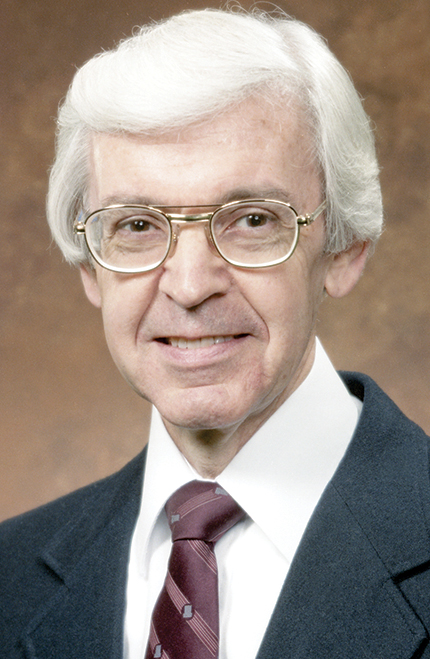Rufus Haynes Ritchie
DOI: 10.1063/PT.3.3905
Rufus Haynes Ritchie, best known for the discovery of the surface plasmon, died peacefully on 29 July 2017 in Gilbert, Arizona. He was a corporate fellow at Oak Ridge National Laboratory (ORNL) and a Ford Foundation Professor of Physics at the University of Tennessee, Knoxville. Called Ritchie by many of his friends and even his wife, Dorothy, he was the very definition of a gentleman and a scholar.

Rufus Haynes Ritchie
OAK RIDGE NATIONAL LABORATORY

Born in the coal-mining camp of Blue Diamond, Kentucky, on 24 September 1924, Ritchie originally studied electrical engineering and earned a bachelor’s degree from the University of Kentucky in 1947. During World War II, he served in the US Army Air Corps and attended military scientific education programs at such schools as Harvard and Yale Universities and MIT. In 1949 he joined the health-physics division at ORNL, where he spent his entire career, except for sabbaticals at Cambridge University’s Cavendish Laboratory and in Denmark. In 1959 he received a PhD in physics, under the supervision of Richard Present, from the University of Tennessee, Knoxville. Several years later he took a joint faculty appointment there in the physics and astronomy department.
The health-physics division at ORNL was created to develop a body of staff members specifically trained in radiation damage to both materials and living tissues. Early on, close collaborations between experimentalists and theorists were strongly encouraged, and they became a hallmark of Ritchie’s work.
In the early 1950s, while analyzing experimental data with Robert Birkhoff, Ritchie became interested in the way energy losses are distributed when a fast electron passes through a thin metal foil. In working out the spectrum to describe how the metal should respond, he discovered the surface-localized collective electronic oscillation now known as the surface plasmon or surface plasmon polariton.
The discovery met fierce resistance from those who doubted that the surface plasmon could exist, and initially Ritchie was hesitant to move forward with his work. However, encouraged by his ORNL colleagues and mentors, such as Birkhoff, Sam Hurst, and Jacob Neufeld, and by David Pines, he published his prediction in a 1957 paper in Physical Review. Three years later a series of electron-scattering experiments at the National Bureau of Standards (now NIST) confirmed surface-plasmon losses.
The full effect of Ritchie’s discovery became clear only years later with the advent of nanotechnology in the late 1990s. The surface plasmon polariton can now be used to confine and manipulate light at the nanoscale, far below the diffraction limit of light. It provides large field enhancements for biosensors, surface-enhanced Raman scattering, diode lasers, and other physical effects. Ritchie’s 1957 paper opened up the new fields of nanoplasmonics and nanophotonics to various uses and has inspired many practical applications in such areas as optoelectronics, photovoltaics, solar energy conversion, and biomedicine.
Ritchie also is regarded as one of the founders of modern radiation dosimetry. For example, he devised quantitative schemes in fast neutron dosimetry by the proportional counter and threshold detector methods. That work was essential for creating the Ichiban program to determine radiation exposure of the survivors of Hiroshima and Nagasaki.
Ritchie was a world leader on the topic of charged particles interacting with solids and surfaces. He developed a dielectric formalism for the response of a quantum plasma and studied electronic wakes, which are the spatial and temporal distributions of electronic fluctuations around fast ions moving in solids or near surfaces. He developed the first nonperturbative theory of interaction of slow ions with matter, a subject highly relevant to the study and application of ion penetration in materials.
Among his many honors were the 1984 Jesse W. Beams Award from the Southeastern Section of the American Physical Society.
An outstanding scientist, Ritchie combined great physical intuition with stellar technical competence and mathematical ability. He could provide in a day or two a model and an elaborate calculation of an idea that had just been discussed. He was able to adapt and improve it almost instantaneously after new aspects were discovered. He was universally respected and admired as a great theoretical physicist.
Ritchie combined, to an unusual degree, a profound knowledge of the fundamentals, a deep sense of the history of scientific culture, and a sympathetic and enthusiastic outlook toward new ideas. The creative nature of his intellect and his accessibility made him not only a superb condensed-matter physicist but also an excellent communicator, teacher, and mentor both in and out of the classroom. More importantly, he was a warm and caring human being, full of love and concern for his family, friends, and coworkers. He will be remembered for his finesse, gentle and generous personality, and almost infinite kindness. His presence is sorely missed.
More about the Authors
Pedro Echenique. University of the Basque Country, San Sebastian, Spain.
Joseph R. Manson. Clemson University, Clemson, South Carolina.
Thomas L. Ferrell. University of Tennessee, Knoxville.
Robert N. Compton. University of Tennessee, Knoxville.
